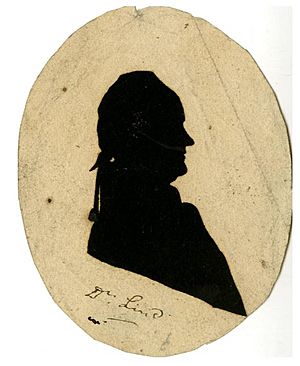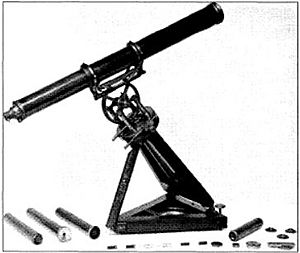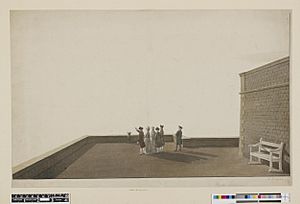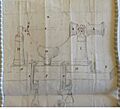James Lind (naturalist) facts for kids
Quick facts for kids
James Lind
FRSE FRCPE
|
|
|---|---|
 |
|
| Born | 17 May 1736 Gorgie, Edinburgh, Scotland
|
| Died | 17 October 1812 (aged 76) Russell Square, London, England
|
| Education | Edinburgh University (MD 1768) |
| Relatives | James Lind |
| Medical career | |
| Profession | Natural philosopher Physician |
| Institutions | Surgeon, East India Company Fellow of the College of Physicians |
James Lind (1736–1812) was a Scottish scientist and doctor. He was known for his wide range of interests, from medicine and astronomy to inventing new machines. He also tutored the famous writer Percy Bysshe Shelley.
Contents
Life and Family
James Lind was born in Gorgie, Edinburgh, Scotland, on May 17, 1736. He studied medicine at Edinburgh University and became a doctor in 1768. Before that, in 1766, he worked as a surgeon for the East India Company.
His Personality
People thought James Lind was a bit unusual and very kind. He was described as tall and thin, with white hair when he was older. One friend said he was "full of benevolence, and even of youthful ardor." He loved puzzles and tricks, which made some people wonder if he was more of a magician than a doctor!
Lind's son, Alexander Francis Lind, wrote that his father had amazing knowledge about many things. He said his father's conversations were very helpful and that he was a gentle and humble person.
His Family
James Lind married Ann Elizabeth Mealy on November 7, 1778. She was described as a tall and handsome woman. They had at least four children. One of their daughters, Lucy Maria Lind, later wrote about Princess Amelia of the United Kingdom. Another daughter, Dorothea Sophia Banks Lind, married Isaac Gosset. Their son, Alexander Francis Lind, became a civil servant and a judge in India.
Connection to Frankenstein
Later in his life, James Lind taught at Eton College. Around 1809, he tutored Percy Bysshe Shelley, who later married Mary Shelley. Percy was fascinated by Lind's experiments, especially those involving electricity and how it could make dead muscles move.
Because of these interesting experiments, many people believe James Lind was a big inspiration for Mary Shelley's famous novel, Frankenstein. It's thought that Mary Shelley had a nightmare after Percy talked about Lind's strange experiments. Lind is also believed to be the inspiration for characters like the blind old man, De Lacey, and Doctor M. Waldman in the book.
Freemasonry
James Lind was also involved in Freemasonry in Scotland. He joined a lodge in 1758 and later held an important position in the Grand Lodge of Scotland.
His Passing
James Lind passed away in London on October 17, 1812, at the age of 76. He had been in pain for several years before his death. He was buried in the crypt of St George's Church in Bloomsbury, London.
His Amazing Career
James Lind was interested in many different sciences, not just medicine. He loved botany (the study of plants), astronomy (the study of stars and planets), meteorology (the study of weather), and chemistry. He also collected old items and drawings, and he was good at making silhouette pictures. He even played the bassoon and flute!
He was friends with many important scientists, like James Watt, who invented the improved steam engine. Watt even mentioned Lind in his own writings.
Career Highlights
Astronomy and Voyages
Lind used a telescope to watch the transit of Venus (when Venus passes in front of the Sun) in 1769. He sent his observations to the Royal Society, a famous scientific group. He also watched an eclipse of the moon from the same spot.
Lind traveled a lot! He collected plants during voyages to places like the Cape of Good Hope and the Comoros Islands.
- He visited China in 1766 and brought back Lemon-grass, which was used to make tea. He even spoke Chinese! He helped create a list of Chinese plants for a famous botanist named Joseph Banks.
- In 1772, he went to Iceland with Joseph Banks and other scientists. They were among the first to climb the Hekla volcano. Lind also measured the height of the Geysir (a famous hot spring) in Iceland.
- He visited South Africa in 1779.
Lind was even considered to be the astronomer for James Cook's second voyage around the world, but plans changed, and he went to Iceland instead. He was also the first to figure out the exact location (latitude) of Islay, an island in Scotland.
Lind also invented a portable wind gauge in 1775, which was a device to measure wind speed. He also designed a rain gauge and a barometer (for measuring air pressure).
Military Work
In 1776, Lind worked with Captain Alexander Blair to create the first rifled cannon. This cannon fired a special lead shot and had a telescopic sight (like a scope on a rifle). Even though it wasn't widely used at the time, the ideas behind it became very important for future weapons.
Working for the King
In 1777, James Lind became a member of the Royal Society of London. Around this time, he moved to Windsor, Berkshire, and later became a doctor for George III, the King of England.
The King asked Lind to do various tasks, like planting a special cabbage garden to protect hares in winter. Lind also advised on farming projects, such as growing mangelwurzel and lima beans.
Lind was interested in forensics (using science to solve mysteries). When the coffin of Edward IV was opened at Windsor, Lind analyzed the remains and liquid inside, describing its appearance and smell.
His Own Printing Press
While at Windsor, Lind had his own printing press. He published several books there, including a book about Scottish noble families. He also wrote some mysterious books using what looked like secret codes, which some people thought might be for a secret society.
Lind also communicated with another scientist, Tiberius Cavallo, about making silhouette portraits. Lind made silhouettes of King George III and Queen Charlotte using his own special method.
Science and Medicine
Lind experimented with using electricity for healing. He thought it could help with certain illnesses, including mental health issues. He even suggested using it to treat King George III's mental illness. He also believed that "animal electricity" was a vital life force.
He built a "Thunder house" to test Benjamin Franklin's ideas about lightning rods. He even had a long rod on his chimney connected to a wire that came into his room, allowing him to charge electric jars and make bells ring!
Lind also built an earthquake machine (a seismograph) to detect ground movements. He experimented with distilling water and treating stomach problems with mercury.
In 1796, Lind made an important discovery. He found that carbon monoxide (a gas) could help treat inflammation in the lungs. This was a very early step in understanding how gases can be used in medicine, and it's still an area of research today! He even designed a special inhaler to deliver this gas.
Lind was also interested in hot air balloons and flying. The King even sent him to inspect a "Machine in the shape of a Bird" that was supposed to carry heavy weights through the air.
Retirement
In his semi-retirement, Lind tutored students at Eton College. This is where he met Percy Bysshe Shelley and introduced him to science and the ideas of famous thinkers like Plato and Benjamin Franklin.
Honors
- 1770 - Elected a member of the Royal College of Physicians of Edinburgh
- 1777 - Elected a member of the Royal Society
- 1783 - Elected a member of the Royal Society of Edinburgh
- Appointed physician to the Royal Household for King George III
Publications
- 1762 - His first paper on "marsh fever" (malaria) in Bengal.
- 1768 - A book about diseases common to Europeans in hot climates.
- 1769 - Papers for the Royal Society about the 1769 transit of Venus and an eclipse of the moon.
- 1775 - A description of his portable wind gauge.
- 1776 - A book describing his rifled cannon.
- 1787 - A book about using mercury to treat inflammatory diseases.
- 1789 - A catalog of Chinese and Japanese plants.
- 1798 - A letter from Lind appeared in a book about the medicinal uses of gases.
- 1800 - A paper on the importance of mathematics in medical education.
Images for kids





